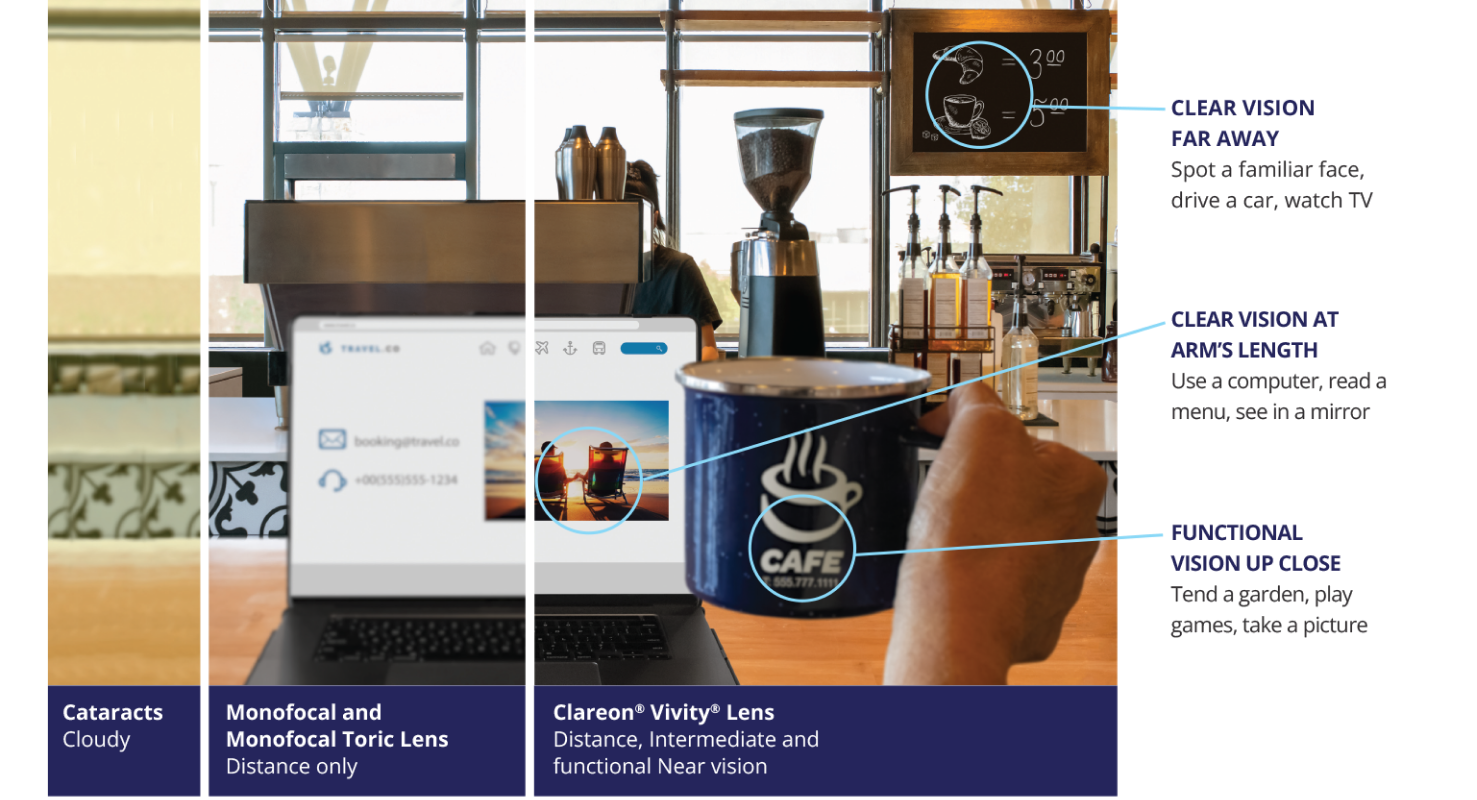Clareon® Vivity® Lens
SEE THINGS DIFFERENTLY
Get the whole picture
Experience Clarity for Everyday Tasks1,2
The standard cataract replacement lens, also called a monofocal lens, allows you to see far away. The Clareon® Vivity® Intraocular Lens allows you to see clearly at the crucial far and intermediate distances while still providing functional near vision.1
Cataracts don’t have to hold you back from doing the things you love. See what makes your life remarkable with the Clareon® Vivity® Lens.

The Clareon® Vivity® Lens Shines a Light on What's Important to you Every Day
In a clinical study with the Vivity® Lens
|
|
94% reported good or very good vision far away without glasses in bright light.1* |
|
|
92% reported good or very good vision at arm’s length without glasses in bright light.1* |
Patients Love Vivity®
In a clinical study, 106 patients were asked about their experience with the Vivity® Lens.


of patients reported that they were satisfied with their vision.3*


of patients reported rarely or never needing eyeglasses or contacts at distance.3*
* Results from a prospective, randomized, parallel group, subject- and assessor-masked, multisite trial of 107 subjects bilaterally implanted with the AcrySof® IQ Vivity® IOL and 113 with the AcrySof® IQ IOL with 6 months follow-up.
Know Your Options,
Put Your Future in Focus
The Clareon® Vivity® Lens allows you to see clearly at far and intermediate distances with functional near vision,1 so that you can immerse yourself in a full range of activities—all while relying less on glasses.1 Here’s a visual example to help you understand the kind of vision improvements that come with the Clareon® Vivity® Lens.

Frequently asked questions About Clareon® Vivity® intraocular lens
Get the information you need to guide you to an informed decision about the cataract replacement lens that best fits your budget and your lifestyle.
WHAT KIND OF INTRAOCULAR LENS IS CLAREON® VIVITY®?
Clareon® Vivity® is an EDOF IOL, or Extended Depth of Focus intraocular lens. It is a type of lens that is used to replace the natural lens of the eye during cataract surgery.
This type of lens is designed to provide a continuous range of vision from near to intermediate with functional near vision, reducing the need for glasses or contact lenses.1,3 EDOF lenses work by creating a gentle blending of the light that enters the eye.1 EDOF lenses are a great option for people who want to reduce their dependence on glasses or contact lenses after cataract surgery.1,3
IS CLAREON® VIVITY® INTRAOCULAR LENS COVERED BY INSURANCE?
Clareon® Vivity® is an Extended Depth of Focus lens. These types of lenses are considered advanced lenses and are more expensive than the standard monofocal intraocular lenses. Typically, an insurance company will not cover elective parts of cataract surgery, including advanced types of lenses and laser-assisted cataract surgery.4 This means that, if you want this type of lens, you will pay out-of-pocket costs for at least part of the procedure. But if the possibility of reducing the dependence on glasses is important to you, the benefits may outweigh the cost. Learn more about the cost of cataract surgery and insurance coverage.
IS THE CLAREON® VIVITY® INTRAOCULAR LENS RIGHT FOR ME?
You have options when it comes to cataract surgery. Choosing the right lens for your needs is a personal decision that should be discussed with your eye surgeon. Clareon® Vivity® is an Extended Depth of Focus lens and generally, these types of lenses are a good option for people who:
• Want to reduce their dependence on glasses: EDOF lenses are designed to provide good vision at far and intermediate distances, which can reduce the need for glasses or contacts.1,3
• Have realistic expectations: While EDOF lenses can improve vision at multiple distances, they may not completely eliminate the need for glasses or contacts, and some patients may experience visual side effects such as halos or glare.1
• Are willing to pay some of the cost out-of-pocket: EDOF lenses are typically more expensive than other types of lenses, which may be a consideration for some patients.
When you invest in your vision, you deserve to know the difference between cataract replacement lens options.
Lead the Conversation
You have options when it comes to your intraocular lenses. Lead the conversation with your doctor to understand the cataract lens choice that’s right for you.
Find a cataract surgeon near you
Use our Cataract Surgeon Finder tool to locate a surgeon near you who offers a range of IOL options

IMPORTANT PRODUCT INFORMATION - CLAREON® FAMILY OF IOLS
CAUTION: Restricted by law to sale by or on the order of a physician.
DESCRIPTION: The Clareon® Family of Lenses are artificial lenses implanted in the eye of adult patients following cataract surgery. The Clareon® Aspheric Hydrophobic Acrylic IOLs are designed to allow for clear distance vision. However, you will likely still need glasses for reading and for distance vision particularly if you already have astigmatism. The Clareon® PanOptix® Trifocal Hydrophobic IOL is a type of multifocal lens (sometimes called “presbyopia-correcting IOL”) designed to allow for clear distance, intermediate, and near vision with the potential to be more independent of the need to use glasses for daily tasks. The Clareon® Vivity® Extended Vision Hydrophobic Posterior Chamber IOL provides clear distance vision, and better intermediate and some near vision compared to a monofocal IOL. The Clareon® Aspheric Toric, Clareon® PanOptix® Toric, and Clareon® Vivity® Toric IOLs are also designed to correct pre-existing corneal astigmatism, which is the inability of the eye to focus clearly at any distance because of difference curvatures on the cornea, and provide distance vision.
WARNINGS / PRECAUTIONS: You may experience and need to contact your eye doctor immediately if you have any of the following symptoms after cataract surgery: itching, redness, watering of your eye, sensitivity to light. The safety and effectiveness of these IOLs have not been established in patients with eye conditions, such as an increase in eye pressure (glaucoma) or complications of diabetes in the eye (diabetic retinopathy). As with any surgical procedure, there are risks involved. These risks may include but are not limited to infection, damage to the lining of the cornea, the retinal layer which lines the inside back wall of your eye may become separated from the tissue next to it (retinal detachment), inflammation or swelling inside or outside the eye, damage to the iris (the colored diaphragm around the pupil), or an increase in eye pressure that cannot be controlled by medicine and secondary surgical procedure. There is a possibility that the IOL may be placed incorrectly or could move within the eye. This may result in less improvement or a reduction in vision, or it may cause visual symptoms. The Clareon® Aspheric Toric, Clareon® PanOptix® Toric, and Clareon® Vivity® Toric IOLs correct astigmatism only when placed in the correct position in the eye. There is a possibility that these Toric IOLs could be placed incorrectly or could move within the eye. This may result in less improvement or a reduction in vision because your astigmatism has not been fully corrected, or it may cause visual symptoms. With the Clareon® PanOptix® and Clareon® Vivity® IOLs, there may be a loss of sharpness of your vision that may become worse in dim light or in foggy conditions. There is also a possibility that you may have some visual effects such as rings or circles (halos) around lights at night. You may also have trouble seeing street signs due to bright lights or glare from oncoming headlights.
ATTENTION: As with any surgical procedure, there are risks involved. Prior to surgery, ask your eye doctor to provide you with the Patient Information Brochure for the lens to be implanted. This Brochure which will inform you of the risks and benefits associated with the IOL. Discuss any questions about possible risks and benefits associated with your eye doctor.
REFERENCES
1. Clareon® Vivity® Extended Vision Hydrophobic IOL (CNWET0) Directions for Use – USA.
2. Werner L, Thatthamla I, Ong M, et al. Evaluation of clarity characteristics in a new hydrophobic acrylic IOL. J Cataract Refract Surg. 2019;45:1490-1497.
3. Alcon Data on File, 2019.
Factors to Consider in Choosing an IOL for Cataract Surgery https://www.aao.org/eye-health/tips-prevention/bestartificial-lens-implant-iol-cataract-surgery Published Dec. 12, 2022. Accessed on March 7, 2023.
